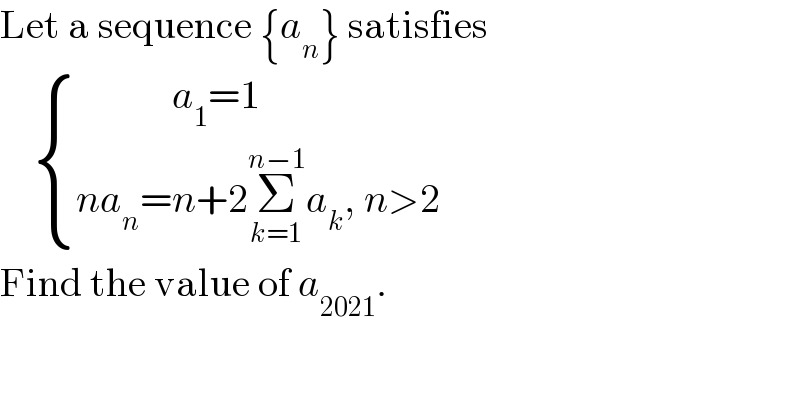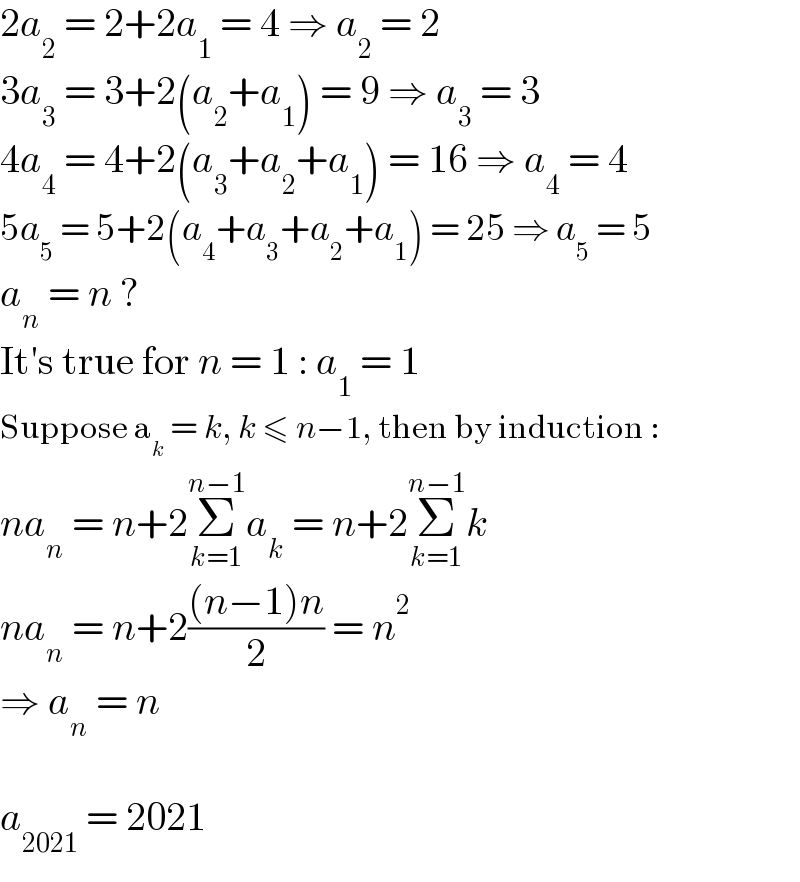
Question Number 129413 by ZiYangLee last updated on 15/Jan/21

$$\mathrm{Let}\:\mathrm{a}\:\mathrm{sequence}\:\left\{{a}_{{n}} \right\}\:\mathrm{satisfies} \\ $$ $$\:\:\:\:\begin{cases}{\:\:\:\:\:\:\:\:\:\:\:\:{a}_{\mathrm{1}} =\mathrm{1}}\\{{na}_{{n}} ={n}+\mathrm{2}\underset{{k}=\mathrm{1}} {\overset{{n}−\mathrm{1}} {\sum}}{a}_{{k}} ,\:{n}>\mathrm{2}}\end{cases} \\ $$ $$\mathrm{Find}\:\mathrm{the}\:\mathrm{value}\:\mathrm{of}\:{a}_{\mathrm{2021}} . \\ $$
Commented byJDamian last updated on 15/Jan/21

$${a}_{\mathrm{2}} \:{is}\:{not}\:{defined},\:{isn}'{t}\:{it}? \\ $$
Answered by Olaf last updated on 15/Jan/21

$$\mathrm{2}{a}_{\mathrm{2}} \:=\:\mathrm{2}+\mathrm{2}{a}_{\mathrm{1}} \:=\:\mathrm{4}\:\Rightarrow\:{a}_{\mathrm{2}} \:=\:\mathrm{2} \\ $$ $$\mathrm{3}{a}_{\mathrm{3}} \:=\:\mathrm{3}+\mathrm{2}\left({a}_{\mathrm{2}} +{a}_{\mathrm{1}} \right)\:=\:\mathrm{9}\:\Rightarrow\:{a}_{\mathrm{3}} \:=\:\mathrm{3} \\ $$ $$\mathrm{4}{a}_{\mathrm{4}} \:=\:\mathrm{4}+\mathrm{2}\left({a}_{\mathrm{3}} +{a}_{\mathrm{2}} +{a}_{\mathrm{1}} \right)\:=\:\mathrm{16}\:\Rightarrow\:{a}_{\mathrm{4}} \:=\:\mathrm{4} \\ $$ $$\mathrm{5}{a}_{\mathrm{5}} \:=\:\mathrm{5}+\mathrm{2}\left({a}_{\mathrm{4}} +{a}_{\mathrm{3}} +{a}_{\mathrm{2}} +{a}_{\mathrm{1}} \right)\:=\:\mathrm{25}\:\Rightarrow\:{a}_{\mathrm{5}} \:=\:\mathrm{5} \\ $$ $${a}_{{n}} \:=\:{n}\:? \\ $$ $$\mathrm{It}'\mathrm{s}\:\mathrm{true}\:\mathrm{for}\:{n}\:=\:\mathrm{1}\::\:{a}_{\mathrm{1}} \:=\:\mathrm{1} \\ $$ $$\mathrm{Suppose}\:\mathrm{a}_{{k}} \:=\:{k},\:{k}\:\leqslant\:{n}−\mathrm{1},\:\mathrm{then}\:\mathrm{by}\:\mathrm{induction}\:: \\ $$ $${na}_{{n}} \:=\:{n}+\mathrm{2}\underset{{k}=\mathrm{1}} {\overset{{n}−\mathrm{1}} {\sum}}{a}_{{k}} \:=\:{n}+\mathrm{2}\underset{{k}=\mathrm{1}} {\overset{{n}−\mathrm{1}} {\sum}}{k} \\ $$ $${na}_{{n}} \:=\:{n}+\mathrm{2}\frac{\left({n}−\mathrm{1}\right){n}}{\mathrm{2}}\:=\:{n}^{\mathrm{2}} \\ $$ $$\Rightarrow\:{a}_{{n}} \:=\:{n} \\ $$ $$ \\ $$ $${a}_{\mathrm{2021}} \:=\:\mathrm{2021} \\ $$
Commented byJDamian last updated on 16/Jan/21

$${but}\:{that}\:{method}\:{is}\:{for}\:{n}>\mathrm{2},\:{not}\:{for}\:{n}=\mathrm{2} \\ $$
